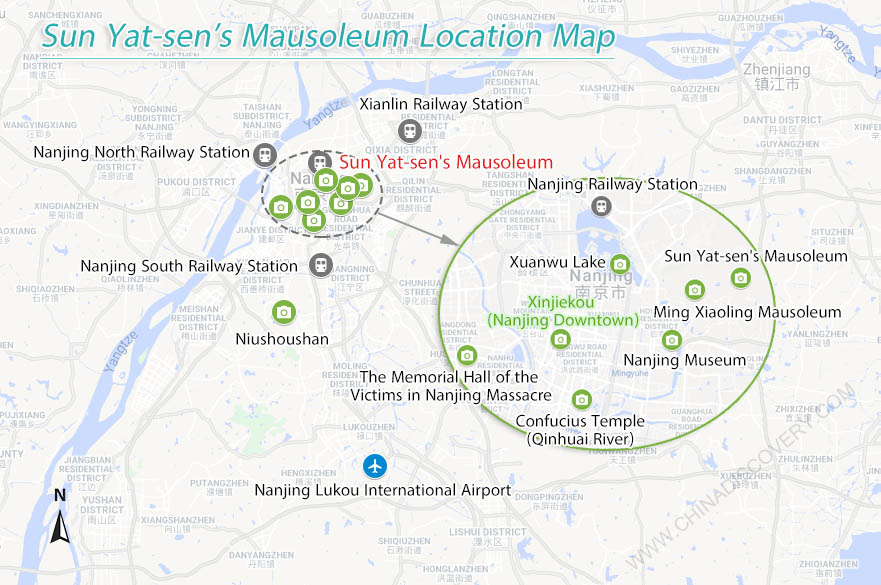Why Visit Sun Yat-sen Mausoleum (Zhongshan Ling)
Sun Yat-sen Mausoleum is the mausoleum for our “Father of Modern China” and the “Forerunner of the Revolution” - Sun Yat-sen (孙中山). With a great and inspiring design, this mausoleum was started in 1926 and completed in 1929 with an area of 80, 000 sq. m. (about 20 acres), located at the south slope of the Purple Mountain facing with fertile plain and leaning against a green mountain, close to Xiaoling Mausoleum to the west and Linggu Temple to the east. It is also Sun Yat-sen's wish to be buried near Purple Mountain.
Sun Yat-sen Mausoleum was listed as “National AAAAA Tourist Attraction” in 2006 and “Architectural Heritage in the 20th Century in China” in 2016.
Sun Yat-sen Mausoleum is a must-see in Nanjing no matter you want to pay respect to this great people or appreciate the beautiful surroundings. Below are some recommended Nanjing tour packages:
☛ 2 Days Ancient Nanjing Tour
☛ 3 Days Best of Nanjing Highlights Tour
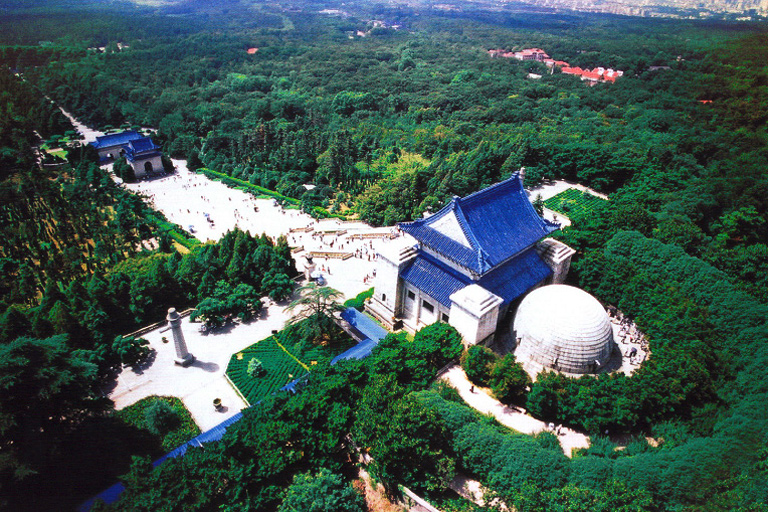 Sun Yat-sen Mausoleum
Sun Yat-sen Mausoleum
About Dr. Sun Yat-sen
To have a better visit to Sun Yat-sen Mausoleum, you should have a further understanding of this great person in China - Sun Yat-sen.
Sun (1866.11.12 ~ 1925.3.12) was a Chinese revolutionary, physician, first president and founding father of the Republic of China (ROC). He is considered to be the “Father of Modern China” (中华民国国父) and the “Forerunner of Democratic Revolution” in the People’s Republic of China. He played a crucial role in the overthrow of the Qing Dynasty (1644~1912) and over 2000 years’ Monarchy during the years leading up to the Xinhai Revolution (辛亥革命). Sun was appointed to serve as Provisional President of the Republic of China when it was founded in 1912 and he later co-founded Kuomingtang and served as its first leader. His political life was with constant struggle and frequent exile. He was exiled to Japan, Europe, the United States, and Canada, but he always supported the revolutionary party and uprising in China. Sun’s chief legacy resides in his development of the political philosophy known as “Three Principles of the People” - Nationalism (民族), People’s Rights (民权) and People’s Livelihood (民生).
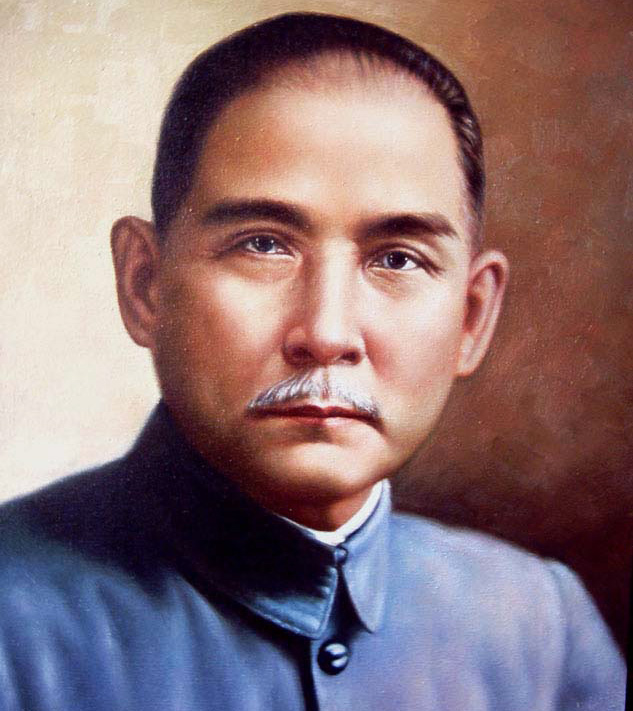 Dr. Sun Yat-sen (孙中山)
Dr. Sun Yat-sen (孙中山)
Layout & Main Architectures of Sun Yat-sen Mausoleum
Reclining on a mountain slope, the architectures are constructed on a north-south axis, blending the styles of traditional imperial tombs and modern architecture. The whole mausoleum area represents an alarm bellying on a green blanket as seen from the air. The Xiao Jing Ding is the alarm’s pinnacle, the half-moon square is the alarm’s arc and the cemetery’s roof is the pendulum of the alarm. It means “awake all the people and build a new China”.
Travelers can follow the most popular visiting route to explore all the essences: Meiling Palace - Sun Yat Sen Mausoleum (Xing Jian Pavilion - Xiao Jing Ding - Philanthropic Archway - Tri-arched Marble Gate - Stele Pavilion - Sacrificial Hall - Vault) - Yin Yue Tai - Guang Hua Pavilion - Sun Yat-sen Memorial Hall - Yang Zhi Pavilion - Liu Hui Pavilion.
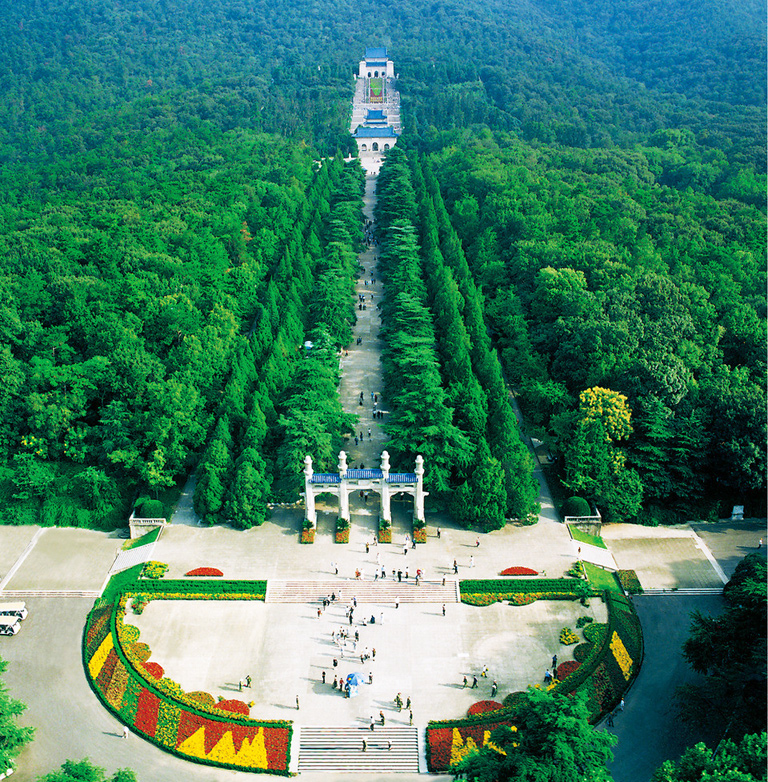 Sun Yat-sen Mausoleum in Alarm Bell Shape
Sun Yat-sen Mausoleum in Alarm Bell Shape
Xiao Jing Ding (孝经鼎)
To commemorate Sun Yat-sen, Dai Jitao (the follower of Sun) and all the students in National Sun Yat-sen University decided to donate a bronze Ding set in front of the vault. This Ding is divided into three parts: the base (drum shape with fine patterns and a star in the middle), the body (three lion heads inscribed “Zhi”, “Ren” and “Yong” in the north side) and the head (a hexagonal pavilion with hexagonal stele inside which inscribed the Classic of Filial Piety).
Philanthropic Archway (博爱坊)
Philanthropic Archway is the entrance to the vault. It is 11 meters tall and 17.3 meters wide with four-poster style three ancient archways. The roof of the archway is blue glazed tile and the body of the archway is decorated with lotus petals, clouds and traditional architectural colored patterns and “Bo Ai” inscribed on the transom which symbolizes the magnanimous heart and profound love.
Tri-arched Marble Gate (陵门)
Beyond is the 480-meter-long and 50-meter-wide stairway which has 392 stairs leading to the vault. On both sides, pine, cypress, and ginkgo trees guard the way. At the end of the stairway is a gate which is 16 meters high and 27 meters wide. The tri-arched marble gate is inscribed with four Chinese characters written by Dr. Sun, "Tian Xia Wei Gong" (天下为公) which means "What is under heaven is for all".
Stele Pavilion (碑亭)
Behind the Marble Gate is the Stele Pavilion at 17 meters tall and 12.2 meters wide. The inscription on the tablet was written by Wang Jingwei, the epitaph was written by Hu Hanmin, biographies were written by Wu Zhihui and narrative prose was written by Zhang Jingjiang.
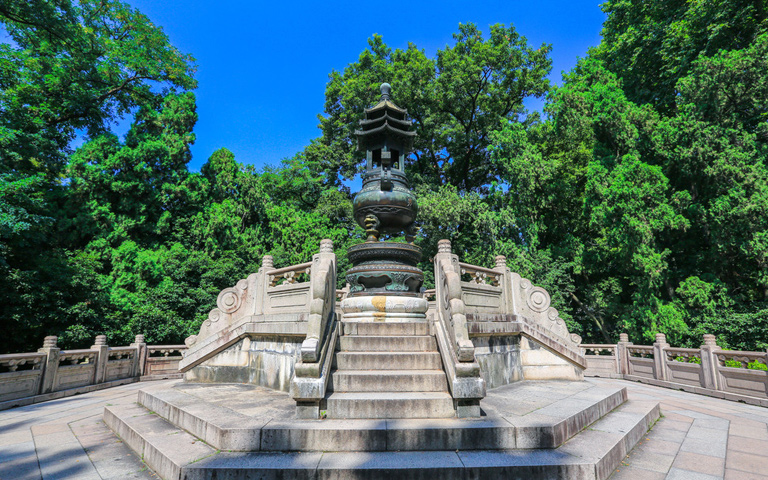 Xiao Jing Ding
Xiao Jing Ding
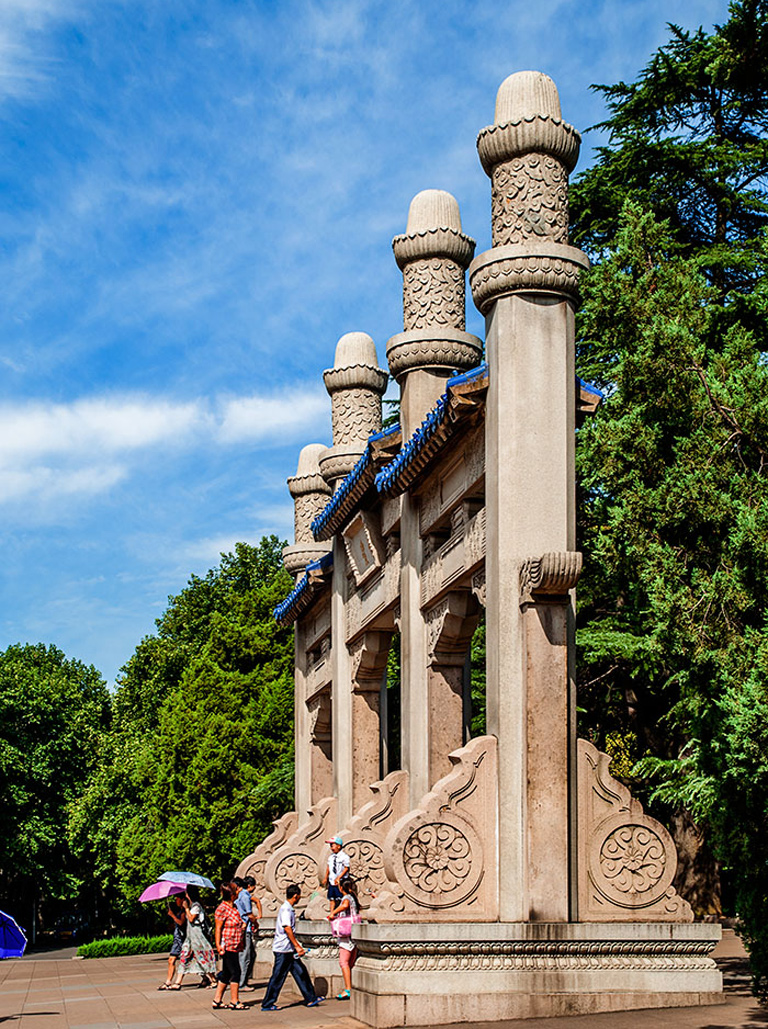 Philanthropic Archway
Philanthropic Archway
Sacrificial Hall (祭堂)
The sacrificial hall is the main architecture of Sun Yat Sen Mausoleum with a blend of Chinese and western styles. It absorbs the traditional mausoleum layout on the central axis with a blue roof and grey white wall which reflects the desire of Dr. Sun Yat Sen to seek democracy. The three arched doors of the Sacrificial Hall are inscribed “Nationalism” (民族), “People’s Rights” (民权) and “People’s Livelihood” (民生). The Principle of Nationalism (民族主义) means independence from imperialist domination. To achieve this Sun believed that China must develop a “China-nationalism” to unite all of the different ethnicities of China in the face of imperialist aggression. The Principle of People’s Rights (民权主义) is translated as “democracy”, literally “People’s power” or “government by the people”. Sun divided the political life of his ideal for China into two sets of “powers”: the power of politics and the power of governance. The power of politics is the power of the people to express their political wishes and the power of governance is the power of administration. The Principle of People’s Livelihood may be understood as social welfare and as a direct criticism of the inadequacies of both socialism and capitalism.
Above the three arched doors, it is inscribed “Tian Di Zheng Qi” (天地正气) which means uprightness in heaven and earth. Going inside the Sacrificial Hall, you can see the white marble sitting statue of Dr. Sun Yat-sen at 4.6 meters tall in the middle of the hall. It is a vivid reflection of Sun working for democracy and revolutionary activities. On the west and east wall inscribed Sun’s Fundamentals of Constitution and Short Political Will. On the dome, it is painted a large emblem of Kuomingtang. Besides, a pair of Huabiao (ancient Chinese ornamental columns) stand in front of the hall which is 12.6 meters high. Looking far away, the Huabiao seems like piercing into the sky with a strong stereoscopic impression.
Vault (墓室)
The vault is at an elevation of 165 meters above sea level. The roof is decorated with mosaic emblem of Kuomingtang, and the ground is decorated with white marbles. In the center of the vault is the coffin pit with white marble sleeping statue of Sun on top. This statue was carved by Gao Qi from the Czech Republic according to the remains of Sun. In the coffin pit are the remains of Dr. Sun Yat-sen. Because of the limited space and for the safety of travelers, the vault is closed for travelers and will open during some important festivals.
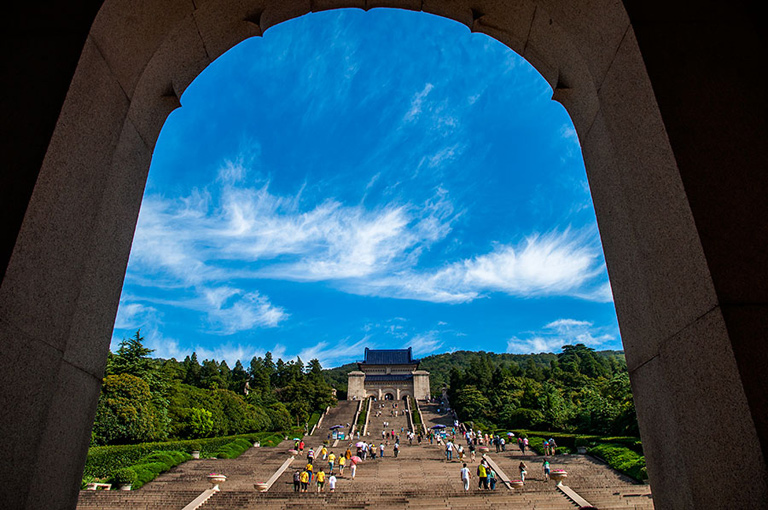 Sacrificial Hall
Sacrificial Hall
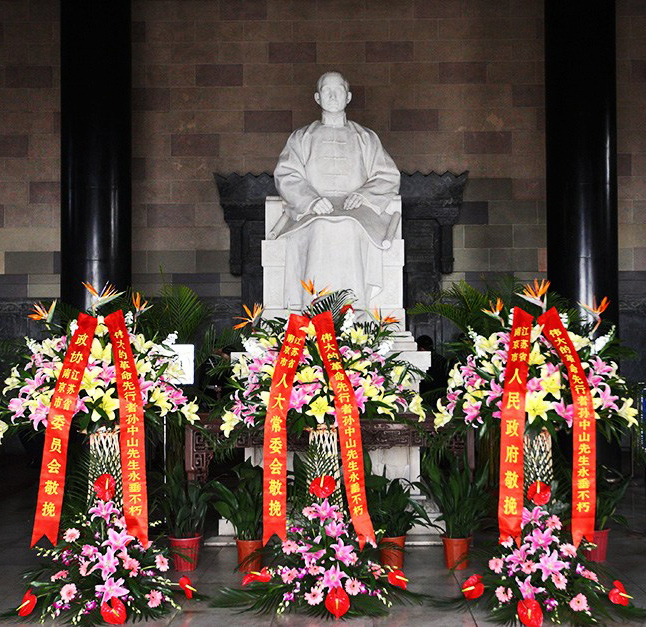 Dr. Sun's Sitting Statue in Sacrificial Hall
Dr. Sun's Sitting Statue in Sacrificial Hall
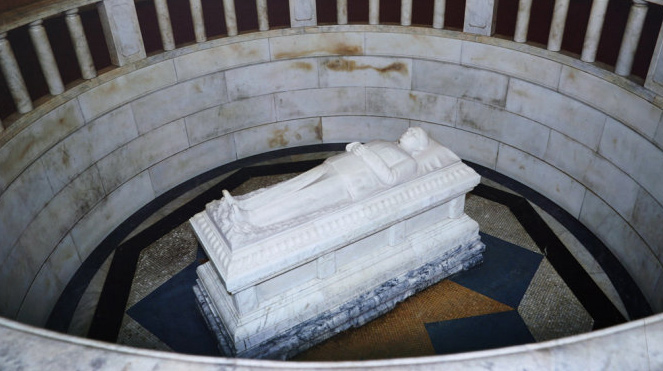 Dr. Sun's Remains in Vault
Dr. Sun's Remains in Vault
Nearby Attractions
Xiaoling Mausoleum of Ming Dynasty (明孝陵)
Type: World Heritage Site; National AAAAA Tourist Attraction; Historic Site
Distance from Sun Yat-sen Mausoleum: 1.3 kilometers
Recommended Visiting Time: about 2 hours
Opening Hours: 06:30~18:00
Ticket: 70 Yuan / person
Xiaoling Mausoleum of Ming Dynasty is the tomb of the Hongwu Emperor, the founder of the Ming Dynasty and his wife Xiaoci Queen. This tomb occupies an area of 170 sq. m., which is one of the largest imperial tombs. Ming Xiaoling Mausoleum is the first Ming tomb standing for the highest accomplishment of Ming Dynasty architecture and stone carving art. It has made great influence on more than 20 imperial tombs in Ming and Qing Dynasties. Hence, it is reputed as “the First Imperial Mausoleum of Ming and Qing Dynasties”. The highlighted spots you won’t miss the Square City, Ming Tower, Great Golden Gate, Sacred Way, Lingxing Gate, the Wenwu Fangmen Gate, the Tablet Hall, the Inner Red Gate, etc.
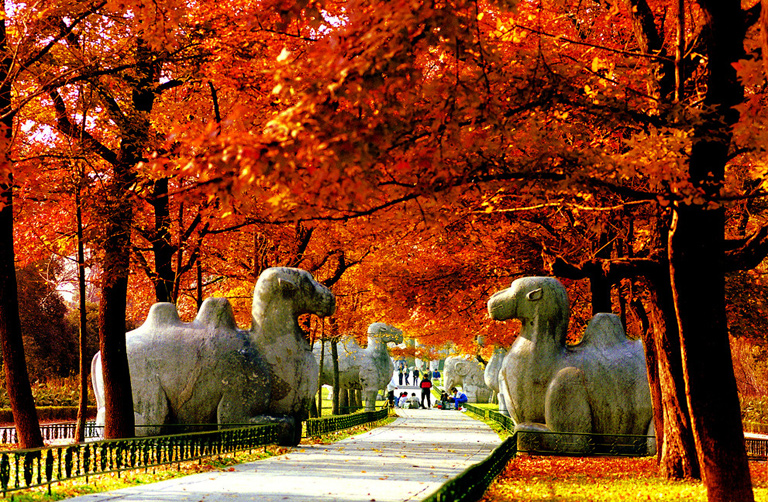 Sacred Way in Xiaoling Mausoleum of Ming Dynasty
Sacred Way in Xiaoling Mausoleum of Ming Dynasty
Linggu Temple (灵谷寺)
Type: Buddhist Temple; Architectural Building; Historic Site
Distance from Sun Yat-sen Mausoleum: 1.5 kilometers
Recommended Visiting Time: about 1~2 hours
Opening Hours: 06:30-18:00
Ticket: CNY 35 / person
Linggu Temple is a Buddhist temple located in the east of Sun Yat Sen Mausoleum in Zhongshan Scenic Area. It was first built in 514 AD in the Southern Dynasties to memorize the famous monk Baozhi and named Kaishan Temple. Later, this temple was renamed as “Linggu Temple” by Hongwu Emperor in Ming Dynasty and granted it “the best Buddhist temple in the world”. Taking a visit to Linggu Temple, you won’t miss Free Life Pond, Jingang Hall, Heavenly Kings Hall, Wuliang Hall, Wufang Hall, Avalokitesvara Hall, and Xuanzang Memorial Hall , etc. See the sitting statue of Xuan Zang in the Xuanzang Memorial Hall and parietal relics in the memorial tower.
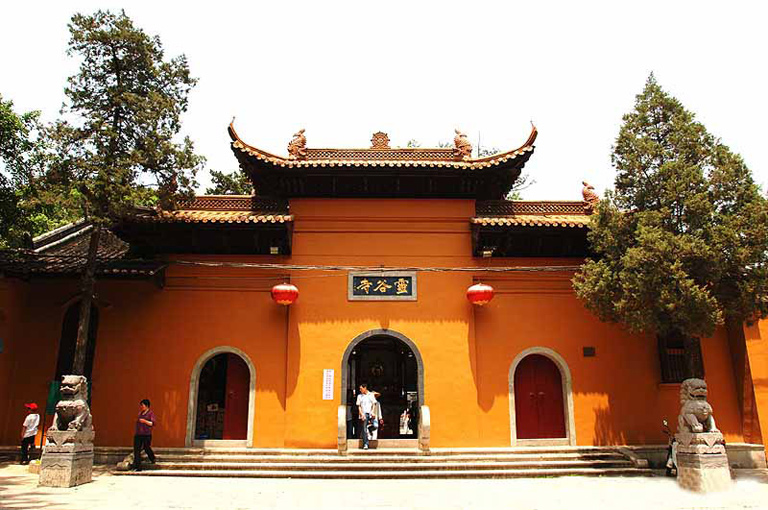 Linggu Temple
Linggu Temple
Location & How to Get to Sun Yat-sen Mausoleum
Sun Yat-sen Mausoleum is located at Zhongshan Scenic Area, the south slope of Purple Mountain. It is very close to Xiaoling Mausoleum of Ming Dynasty to the west and Linggu Temple to the east. Within half an hour’s drive, you can reach from the main tourist attractions and railway station to Sun Yat-sen Mausoleum.
Distance to Other Places in Nanjing
- About 13 kilometers from Confucius Temple
- About 14.5 kilometers from Zhonghua Gate
- About 13 kilometers from Nanjing Railway Station
- About 18 kilometers from Nanjing South Railway Station
- About 47 kilometers from Nanjing Lukou International Airport with 50 minutes’ drive
Get to Sun Yat-sen Mausoleum
For independent travelers, you can take a metro from downtown area to Sun Yat-sen Mausoleum. Moreover, buses are available between Xiaoling Mausoleum of Ming Dynasty and Sun Yat-sen Mausoleum, Linggu Temple and Sun Yat-sen Mausoleum.
Travel with China Discovery
If you want to get rid of hustle of public transportation and troublesome navigation, you can take a private tour package which covers sightseeing, dining and transfer from us. Our local tour guide and driver will escort you to visit Sun Yat Sen Mausoleum with speed and convenience, and take care of all the details. You just need to focus on sightseeing.
Useful Travel Tips
1. Lots of Stairs to Climb
From the entrance gate to the vault, travelers need to climb a lot of stair up. It is suggested to take less carry-on luggage and wear comfortable shoes when visiting Sun Yat Sen Mausoleum.
2. Sightseeing Train
To save your energy and time, travelers can take the sightseeing train between Muxuyuan Metro Station and Zhongshanling South Station. You can stop at Sifang Cheng, Meiling Palace and Underwater World. It charges 10 Yuan / person for each way.
3. English & Chinese Audio Service
Travelers can rent audio device to better understand Sun Yat Sen Mausoleum and Dr. Sun Yat Sen. It charges 10 Yuan for Chinese explanation and 20 Yuan for English, Japanese, Korean explanation.
How to Plan Your Travel in Nanjing
How to Get to Nanjing: You can easily get to Nanjing by high speed train from Beijing (about 3-5h), Shanghai (about 1-2.5h), Hangzhou (about 1.5-5.5h), Suzhou (about 45min-2.5h), etc. and flight from Beijing (2h), Guangzhou (2h15min), Chengdu (2.5h), Xian (2h), etc.
Best Time to Visit Nanjing: March to June and September to November, especially in late October and early November.
Generally, to explore the cultural and natural highlights of Nanjing, 2 ~ 3 days are needed. You can pay a visit to Sun Yat-sen Mausoleum (the tomb of Dr. Sun Yat-sen, the Father of Modern China), take a walk in Confucius Temple Area along the Qinhuai River, climb up the ancient City Wall, and know a part of heavy history and cherish peace in the Memorial Hall of the Victims in Nanjing Massacre.
☛ 2 Days Ancient Nanjing Tour
☛ 3 Days Best of Nanjing Highlights Tour
If you want to explore more about Jiangsu Province, you can travel to Suzhou - the city of classical gardens and silk, Wuxi - a beautiful lakeshore city, Yangzhou - old culture center of southern China, etc. Check more about Jiangsu Tours>
☛ 5 Days Jiangsu Tour (Suzhou, Wuxi & Nanjing)
If you have more days, you can expand your Nanjing trip to Shanghai - modernest metropolis in China, Hangzhou - home to picturesque West Lake, and Huangshan - magnificent Yellow Mountain and Hui-style ancient villages. Or you can contact us to customize a trip according to your own itinerary and interests. Just tell us your needs and we will take care of everything, you just need to focus on sightseeing!
☛ 5 Days Shanghai & Nanjing Highlights Tour
☛ 8 Days East China Tour by High-speed Train
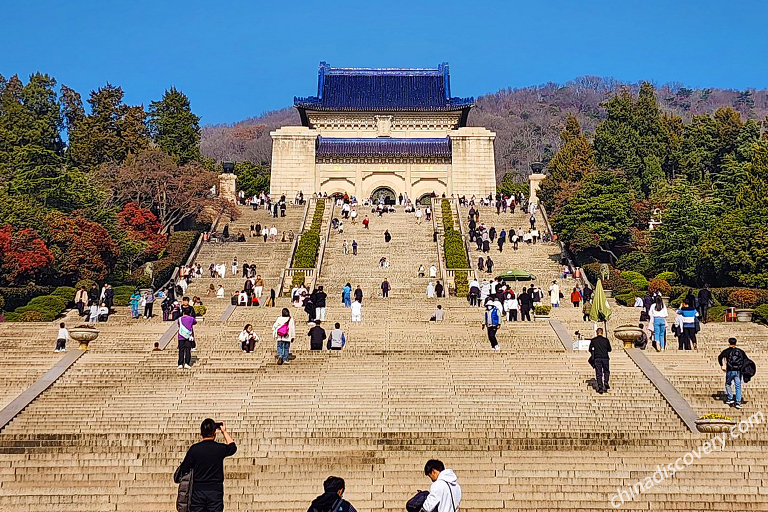 Sun Yat-sen Mausoleum in Nanjing
Sun Yat-sen Mausoleum in Nanjing
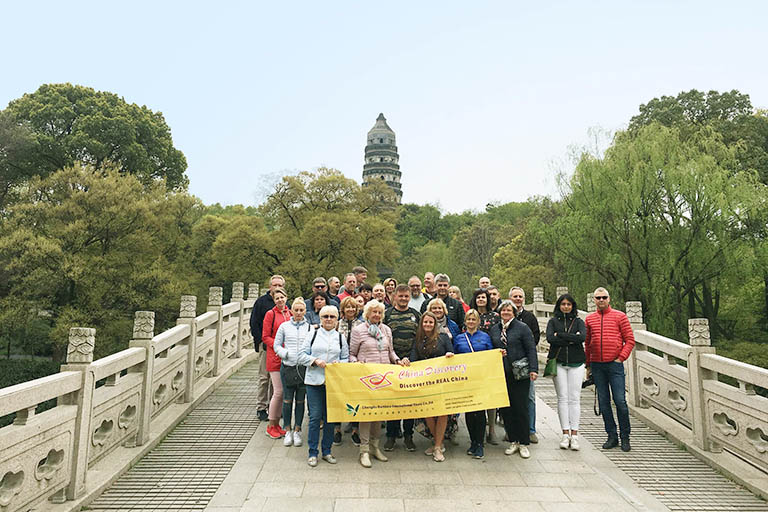 Our Customers visited Tiger Hill in Suzhou
Our Customers visited Tiger Hill in Suzhou
Get Inspired by Real Travel Stories of Our Customers
Since 2012, we have helped numerous customers visit Nanjing and surroundings. With our fully-inclusive private tour packages, all of our customers enjoyed their trips to the ancient city wall, beautiful Purple Mountain, informative Nanjing Museum, charming Qinhuai River, etc. Some of them kindly shared their precious photos and stories about their Nanjing journey, just get inspired now.
"This is my second time to ask China Discovery to organize a private tour for a group of 12 people to visit Huangshan, Hangzhou, Nanjing, Suzhou, Shanghai and other cities close-by…" - shared by Mr. Ban (Check his Travel China with Family and Friends for 3 Consecutive Years - Mr. Ban's Group Traveled Different Parts of China from the North to Southwest and Southeast)
Besides the wonderful travel stories, many customers who visited Nanjing with China Discovery also send us their first-hand feedbacks about their trip, feel free to read the Customer Reviews and learn what they say about their experience. If you want to start your Nanjing tour now, don't hesitate to contact us.
 Our Customers Mr. Ban and his group from the USA visited Shanghai, Nanjing, etc. customized by Vivien
Our Customers Mr. Ban and his group from the USA visited Shanghai, Nanjing, etc. customized by Vivien
- 2 Days Nanjing Essence Tour
- 3 Days Nanjing Tour with Niushoushan
- 4 Days Nanjing History & Culture Tour
Nanjing Tours
- Nanjing Museum
- Nanjing Massacre Memorial Hall
- Niushoushan
- Things to do & Top Attractions
- Get There & Around
- Weather & Seasons
- Accommodation
- Nanjing Maps
- How to Plan A Nanjing Tour
- More Nanjing Travel Guide
Nanjing Travel Guide
More about Jiangsu Travel Guide
Recommended Nanjing Tours
Top 3 Nanjing tours chosen by most customers to explore Nanjing in the best way. Check the detailed itinerary, or tailor your own trip now with us.

5 Days Shanghai Nanjing Highlights Tour
Shanghai / Nanjing
Start planning your tailor-made holiday to China by contacting one of our specialists. Once inquired, you’ll get a response within 0.5~23.5 hours.
Customize a TripHave a question? Get answers from our travel experts or guests
- Your Question:
- Your Name:
- Your Email:
- Submit


























